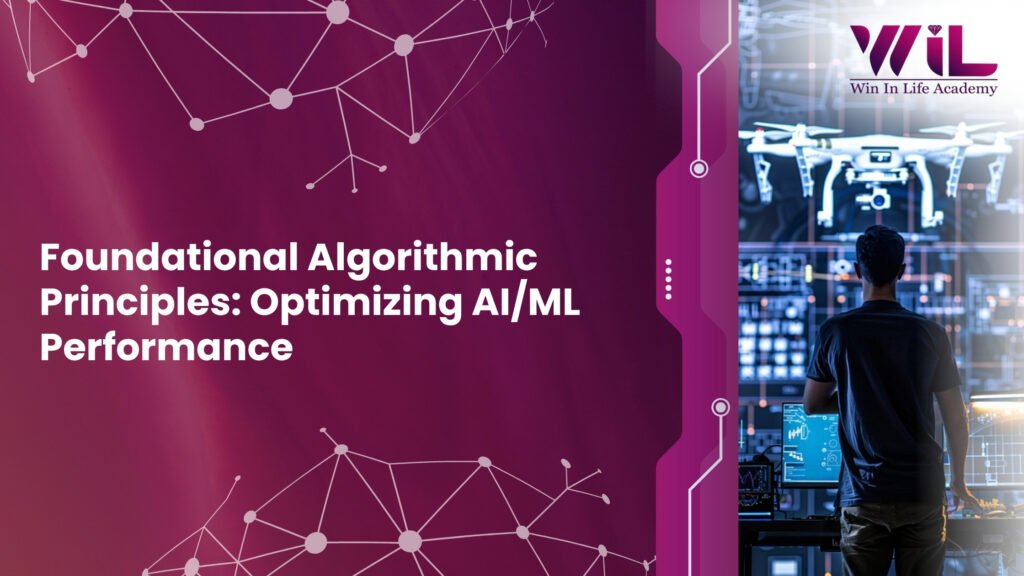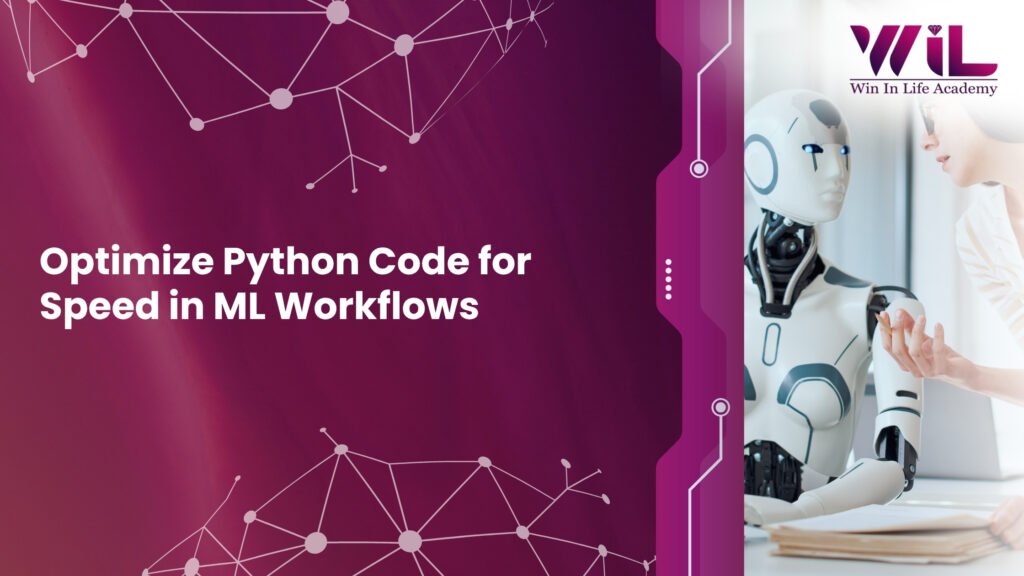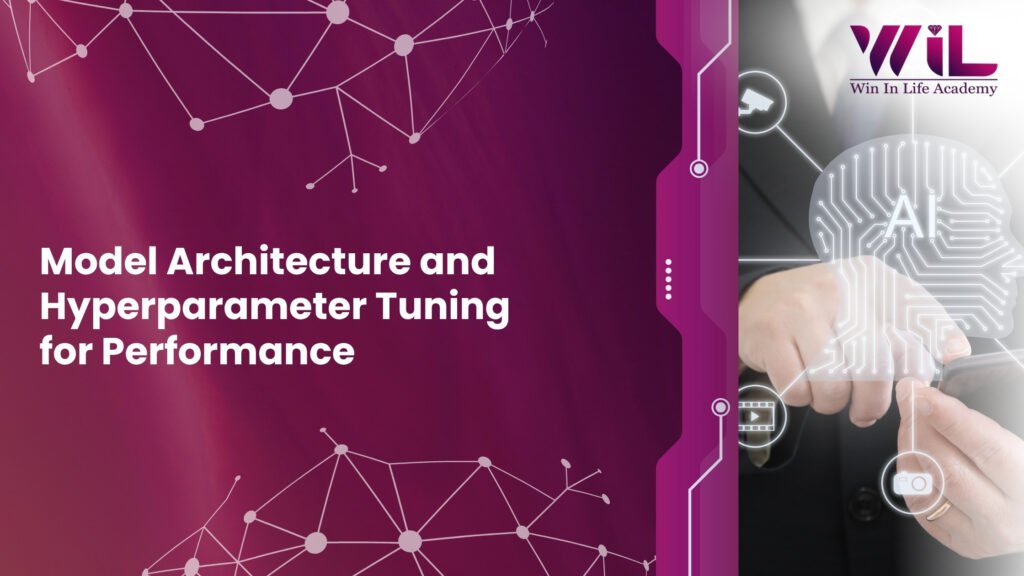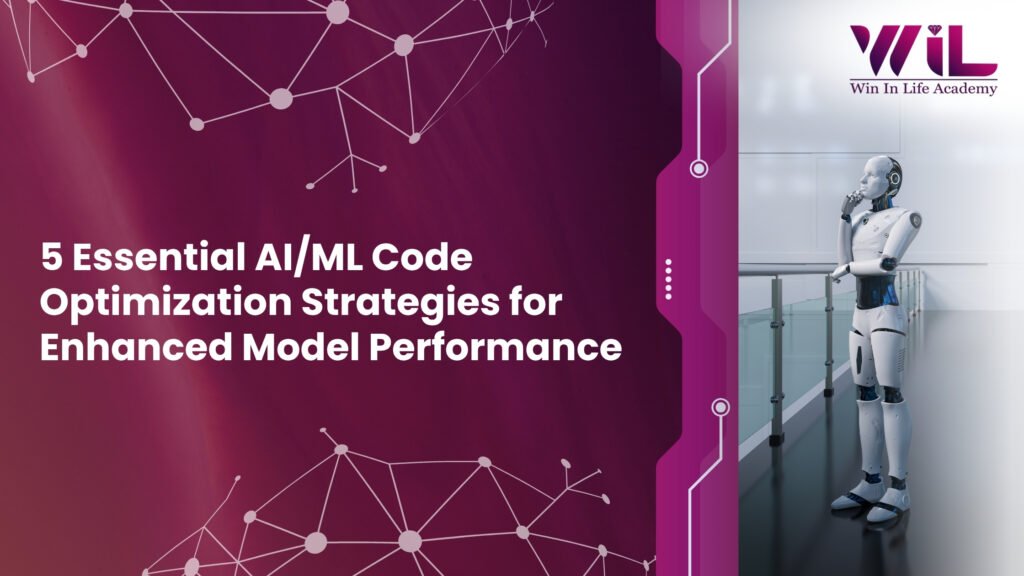In Artificial Intelligence and Machine Learning, innovation moves at an unparalleled rate. From groundbreaking large language models to computer vision systems, the capabilities of AI are expanding daily. Yet, beneath the impressive surface of these intelligent applications lies a critical, often underestimated, determinant of their success: Code Optimization. It is the invisible engine that dictates not just how fast a model trains, but also how efficiently it infers, how scalable an AI solution becomes, and ultimately, how cost-effective its deployment is.
For anyone serious about excelling in AI and ML, understanding and mastering code optimization is not merely an optional skill; it is a fundamental prerequisite for building robust, high-performing, and deployable AI systems.
Consider a data scientist struggling with model training for days, or an ML engineer deploying a real-time inference service that chokes under load. In both scenarios, the bottleneck often traces back to unoptimized code. While powerful libraries like TensorFlow and PyTorch handle much of the heavy lifting, the glue code, data preprocessing pipelines, custom layers, and even the way models are structured can significantly impact performance.
This comprehensive guide will enlighten the profound importance of code optimization within AI and ML, detailing its multifaceted aspects from fundamental principles to advanced techniques. We will reveal 5 strategic imperatives that will empower you to Python code optimizer online for speed, effectively utilize an online code optimizer, and build AI/ML solutions that stand out for their efficiency, scalability, and performance.
Enroll Now: AI and ML course
1. The Strategic Imperative of Code Optimization in AI/ML
At its core, Code Optimization in AI/ML is the process of modifying algorithms and implementations to run more efficiently, consuming less computational resources (CPU, GPU, memory) and completing tasks in less time. While speed and resource efficiency are primary drivers, the strategic implications in AI/ML are far broader.
Accelerated model training is a key benefit, as training complex AI models, especially deep neural networks, is incredibly compute-intensive. Optimized code directly translates to faster training cycles, enabling quicker experimentation, more iterations, and ultimately, better model convergence and performance, which is crucial for data scientists to fine-tune models and achieve state-of-the-art results more rapidly.
Furthermore, enhanced inference speed is vital for real-time AI applications such as autonomous driving, fraud detection, or live translation, where lightning-fast inference is non-negotiable. Optimized code ensures that models can process new data and make predictions within strict latency requirements, providing immediate value and improving user experience.
Reduced operational costs are another significant advantage, as cloud-based AI infrastructure charges based on compute time and resource usage. Highly optimized code minimizes these resource footprints, leading to significant cost savings in both training and subsequent model deployment and serving, making large-scale AI projects more financially viable.
Improved scalability is also a direct outcome, as efficient code can handle larger datasets and more concurrent requests without degrading performance. This makes AI solutions robust and ready for production at scale, allowing businesses to expand their AI services to a wider user base or process growing volumes of data seamlessly.
Moreover, greater iteration velocity is achieved when code runs faster, enabling data scientists and ML engineers to iterate ideas more quickly, test more hypotheses, and accelerate the entire research and development lifecycle. This rapid prototyping and experimentation are vital for staying competitive in the fast-evolving AI landscape.
Finally, deployment feasibility on edge devices is a critical consideration; for AI to operate on resource-constrained edge devices such as IoT sensors, mobile phones, or embedded systems, models and their surrounding code must be meticulously optimized for minimal memory and power consumption. This enables widespread, decentralized AI applications.
Optimized code also leads to better resource utilization, ensuring that expensive hardware, whether GPUs, TPUs, or specialized AI accelerators, purchased or leased for AI tasks is utilized to its fullest potential, maximizing the return on investment for high-performance computing resources.
In essence, code optimization transforms an AI concept from a theoretical possibility into a practical, deployable, and economically viable solution, bridging the gap between research and real-world impact.
2. Foundational Algorithmic Principles: Optimizing AI/ML Performance

While low-level code adjustments are valuable, the most profound performance gains in AI and ML often stem from the judicious selection and refinement of algorithms. The choice of algorithm dictates the fundamental computational complexity and resource requirements, far outweighing the impact of micro-optimizations on a suboptimal algorithmic foundation.
A deep understanding of computational complexity, often expressed using Big O notation, is paramount for any AI/ML professional. It is crucial to know whether an algorithm runs in O (N log N), O(N^2), or even O(2^N) for data processing; model training, or inference is crucial. For instance, selecting an O (N log N) sorting algorithm for a large dataset in a data preprocessing pipeline will drastically outperform an O(N^2) algorithm when dealing with millions of data points, saving hours or even days of computation.
The choice of data structure also directly impacts algorithm efficiency. Using hash maps (Python dictionaries) for fast lookups, which average O (1) time complexity, instead of lists for searching, which are O(N) on average, can yield massive speedups in feature engineering or data indexing within ML pipelines.
Similarly, using sets for checking membership can be significantly faster than lists. Many AI/ML tasks involve sorting or searching large collections of data, such as ranking search results, preparing data for clustering, or finding nearest neighbors. Implementing or utilizing highly optimized algorithms like Merge Sort, Quick Sort (both typically O (N log N)), or specialized search trees can drastically reduce execution time for large inputs.
Binary search, for instance, offers a logarithmic time complexity (O (log N)) for sorted data, a vast improvement over linear search.
In scenarios involving graph-structured data, such as social networks, knowledge graphs in Natural Language Processing (NLP), or recommender systems, efficient graph traversal and analysis algorithms like Breadth-First Search (BFS), Depth-First Search (DFS), or shortest path algorithms (e.g., Dijkstra’s, A*) are critical for timely processing and insights.
Furthermore, while not strictly “speed” optimization, ensuring the numerical stability of algorithms, for example, preventing vanishing or exploding gradients in neural networks, indirectly optimizes by allowing models to converge faster and more reliably. Unstable algorithms can lead to prolonged training times or even outright failure to converge, effectively halting progress.
Lastly, for NP-hard problems common in optimization within AI/ML, such as complex hyperparameter tuning, large-scale feature selection, or combinatorial optimization tasks, understanding when and how to apply efficient approximation algorithms or heuristics can provide practical, although non-optimal, solutions within a reasonable timeframe, where exact solutions might be computationally infeasible.
In AI/ML, selecting the right algorithm is the first and most impactful step towards true Code Optimization, providing a superior foundation upon which further efficiencies can be built. A brilliant algorithm can make even a moderately optimized implementation shine.
3. Optimize Python Code for Speed in ML Workflows

Python has become the de facto language for AI and ML due to its rich ecosystem of libraries, ease of use, and readability. However, its interpreted nature means that inefficient Python code can quickly become a bottleneck, especially when dealing with large datasets or complex computations. Learning Python code optimizer online for speed is therefore an essential skill for any AI/ML practitioner. It’s about writing Pythonic code that leverages its strengths while consciously mitigating its essential costs.
A critical strategy is to embrace vectorization and NumPy, as this is arguably the single most important optimization for numerical computations in Python-based AI/ML. Instead of explicit, slow Python for loops, leverage NumPy’s highly optimized, C-implemented array operations. Operations like matrix multiplication, element-wise arithmetic, and aggregations are dramatically faster when vectorized, often by orders of magnitude.
This principle applies not just to model training with frameworks like TensorFlow or PyTorch but also to the intensive data preprocessing steps that lead it. Furthermore, leveraging built-in functions and list comprehensions is highly beneficial, as Python’s built-in functions, such as sum (), len(), min (), max (), map (), and filter (), are implemented in C and are significantly faster than writing custom Python loops for the same logic.
Similarly, list comprehensions, which provide a concise way to create lists, are generally more efficient and readable than traditional loops with append (), often leading to speed improvements due to their optimized internal implementation.
For large data, employing generator expressions is crucial. For processing massive datasets that may not fit entirely into memory, generator expressions (e.g., (x for x in my_list if condition)) are invaluable. They create iterators that yield items one by one on demand, consuming significantly less memory than creating entire lists in memory. This is particularly useful in data pipelines for loading and processing large files or streams of data efficiently.
Efficient string operations are also important for text processing tasks common in Natural Language Processing (NLP) workflows; using “”. join(list_of_strings) for concatenating multiple strings is far more efficient than repeated + operations. This is because strings in Python are immutable, meaning each + operation creates a new string object in memory, leading to performance degradation and increased memory usage in loops.
Crucially, one must profile code rigorously. The expression “measure, don’t guess” is paramount in performance optimization. Do not guess where bottlenecks lie. Use Python’s built-in cProfile and timeit modules, or external tools like line_profiler or memory_profiler, to pinpoint the exact functions or lines of code consuming the most CPU time or memory. This data-driven approach ensures that your optimization efforts are targeted precisely where they will yield the greatest impact.
Similarly, using appropriate data structures, such as dictionaries for fast lookups (average O (1)) and sets for efficient membership testing, can lead to significant speedups compared to using lists for these operations. Avoiding unnecessary object creation in performance-critical loops, especially when dealing with large volumes of data, can reduce the overhead associated with Python’s garbage collection, contributing to faster execution.
For demanding scenarios, JIT compilers like Numba and PyPy can be transformative. For functions or critical sections of code that remain slow even after applying vectorization and other Pythonic optimizations, Just-In-Time (JIT) compilers like Numba can provide dramatic speedups.
- Numba compiles Python code to optimize code online, often accelerating numerical code that operates on NumPy arrays.
- PyPy is an alternative Python implementation with a JIT compiler that can accelerate many types of Python code by optimizing frequently executed paths.
Finally, for extreme performance, Cython allows you to write Python code with static type declarations, enabling it to be compiled into C extensions. This provides near C-like performance while retaining much of Python’s expressiveness, making it a powerful tool for developing custom, performance-critical components in ML frameworks or specialized algorithms. AI/ML practitioners can unlock substantial performance gains by applying these Python-specific optimization techniques which transform sluggish scripts into high-speed computational engines capable of handling the demands of modern AI workloads.
4. Data Pipeline Optimization
In AI/ML, data is a priority, and the pipeline that prepares and feeds this data to your models is often the biggest barrier, even more so than the model training itself. An unoptimized data pipeline can lead to GPU starvation, where the GPU sits idle waiting for data, extended training times, and inefficient resource utilization. Addressing these bottlenecks is crucial for end-to-end efficiency.
Efficient data loading is a primary concern. One should utilize efficient data loaders provided by popular frameworks such as tf.data in TensorFlow or DataLoader in PyTorch. These mechanisms are designed to load data in parallel, prefetch batches, and leverage multiple CPU cores, ensuring that the GPU remains constantly busy and avoids being starved of data. Concurrently, data preprocessing optimization is key.
Identify and optimize code online computationally intensive preprocessing steps. If possible, perform fixed preprocessing steps offline (e.g., scaling, normalization, tokenization for static text data) once, rather than repeatedly during every training epoch. For real-time inference, ensure preprocessing is as lean and fast as possible to minimize latency. Libraries like Dask or Spark can be used for large-scale, parallel preprocessing.
Data augmentation strategies, while crucial for improving model generalization and preventing overfitting, can be compute-intensive. Consider offloading augmentation to the CPU, using specialized augmentation libraries (e.g., Albumentations for computer vision), or pre-computing augmentations when feasible, especially for small datasets.
For real-time augmentation during training, ensure the implementation is highly optimized to avoid becoming a barrier. Memory management in data loaders is also vital for large datasets that exceed available RAM, implement custom data generators, or use framework-provided tools that load and process data in smaller batches or streams. This approach effectively manages memory by only loading necessary data segments, preventing out-of-memory errors and enabling training on datasets larger than physical memory.
The choice of data compression and formats significantly impacts performance. Choose efficient data storage formats that offer better compression and faster read/write speeds than raw CSV or JSON. Formats like Parquet, TFRecord, HDF5, or even highly optimized binary formats are ideal for large datasets, significantly reducing I/O time and disk space requirements.
For truly massive datasets that cannot be processed on a single machine, distributed data processing frameworks like Apache Spark, Dask, or Ray enable the parallelization of data cleaning, transformation, and feature engineering across multiple machines or clusters, drastically accelerating data preparation.
Finally, complex feature engineering, especially involving transformations across multiple data points or time series, can be a major computational cost. Profiling these steps and actively looking for opportunities to vectorize computations, cache intermediate results, or implement more efficient algorithms for feature generation is highly recommended.
Optimizing the data pipeline ensures a steady, high-throughput flow of information to your models, minimizing idle compute resources, preventing bottlenecks, and significantly accelerating the entire ML lifecycle from data ingestion to model training.
5. Model Architecture and Hyperparameter Tuning for Performance

While not directly “code” optimization in the traditional sense, the choices made in model architecture and hyperparameter tuning have a profound and often overlooked impact on computational efficiency. These decisions are integral to the overall optimization strategy in AI/ML. The balance between model complexity and performance is a crucial consideration. Larger, more complex models, such as deeper neural networks with a vast number of parameters, generally require significantly more computation for both training and inference. Striking the right balance between achieving high model performance (e.g., accuracy, F1-score) and managing computational cost is crucial.
Techniques like pruning, quantization, and knowledge distillation are specifically designed to reduce model complexity without a significant degradation in performance, making them more efficient for deployment. Leveraging efficient network architectures is another key aspect. Research and utilize state-of-the-art, computationally efficient network architectures. For example, in computer vision, models like MobileNet, EfficientNet, or ShuffleNet variants are specifically designed to be highly accurate yet require fewer Floating-Point Operations Per Second (FLOPs) and parameters compared to older, larger models like VGG or ResNet, making them suitable for mobile or edge deployments.
In NLP, efficient transformers (e.g., Linformer, Performer) aim to reduce the quadratic complexity of attention mechanisms, offering similar performance with less computational overhead. Hyperparameter tuning, while primarily focused on optimizing model performance metrics, also directly impacts training efficiency. For instance, an optimal learning rate can lead to faster model convergence, thereby reducing the total training time. Batch size significantly influences GPU utilization: a batch size that is too small can lead to underutilization of expensive GPU resources, while one that is too large might lead to out-of-memory errors or slower convergence in the era. Tuning batch size correctly is key to optimization.
Regularization techniques like dropout or L1/L2 regularization, while primarily aimed at preventing overfitting and improving generalization, can sometimes indirectly simplify the model by forcing scarcity or reducing reliance on specific features, potentially leading to faster training or inference by reducing effective complexity. Batch Normalization and Layer Normalization are widely used in deep learning to improve training stability and often allow for the use of higher learning rates. This leads to faster model convergence, which directly translates to reduced training time and thus, faster training processes.
Lastly, mixed precision training, which involves leveraging lower-precision floating-point numbers, such as FP16 (half-precision) instead of FP32 (single-precision), for training, can significantly reduce memory usage for weights and activations. On compatible hardware (like NVIDIA Tensor Cores), it can also double the effective FLOPs, dramatically accelerating training of large models with minimal loss in accuracy.
This is a common and powerful optimization for deep learning. Through considerately designing model architectures and carefully tuning hyperparameters, AI/ML practitioners can achieve substantial performance gains that complement low-level code optimizations.
Final Thoughts
The advancements in Artificial Intelligence and Machine Learning are undeniably exciting, but the journey from an initial idea to a deployable, high-performing solution is paved with meticulous engineering and strategic decision-making. At the core of this journey lies Code Optimization. It’s the silent force that transforms theoretical models into practical powerhouses, converting extended training times into rapid experimentation cycles, and turning slow inferences into real-time insights.
From mastering the nuances of a python code optimizer online to implementing sophisticated model compression techniques and leveraging the prowess of an online code optimizer, every AI/ML professional must embrace these principles.
Optimized code is not just about raw speed; it’s about building scalable, cost-effective, and robust AI systems that can truly make an impact. It’s about maximizing the return on investment for expensive compute resources and accelerating the pace of innovation. By integrating these 10 strategic imperatives into your AI/ML development workflow, you will not only write faster code but also build smarter, more efficient, and more reliable intelligent applications.
Are you ready to transforming by mastering the technical depths that define true excellence in AI and Machine Learning?
Win In Life Academy offers cutting-edge courses in AI and ML that delve into these critical areas, providing the hands-on experience, expert guidance, and industry-relevant curriculum you need to transform your understanding into actionable, high-impact skills. Accelerate your career, build pioneering AI solutions, and become an indispensable leader in the era of artificial intelligence.
Visit Win in Life Academy today to explore our comprehensive AI and ML programs and unlock your full potential in this transformative field!
References
Code Optimization in Compiler Design
https://www.geeksforgeeks.org/compiler-design/code-optimization-in-compiler-design
Code Optimization
https://www.sciencedirect.com/topics/computer-science/code-optimization
Reasons for Optimizing the Code
https://byjus.com/gate/code-optimization-in-compiler-design-notes





